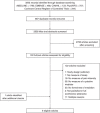Sleep and Pain: A Systematic Review of Studies of Mediation
- PMID: 30829737
- PMCID: PMC6504189
- DOI: 10.1097/AJP.0000000000000697
Sleep and Pain: A Systematic Review of Studies of Mediation
Abstract
Objectives: A relationship between sleep and pain is well established. A better understanding of the mechanisms that link sleep and pain intensity is urgently needed to optimize pain management interventions. The objective of this systematic review was to identify, synthesize, and critically appraise studies that have investigated putative mediators on the path between sleep and pain intensity.
Methods: A systematic search of 5 electronic bibliographic databases (EMBASE, MEDLINE, CINAHL, PsycINFO, and the Cochrane Central Register of Controlled Trials) was conducted. Eligible studies had to apply a formal test of mediation to variables on the path between a sleep variable and pain intensity or vice versa. All searches, data extraction and quality assessment were conducted by at least 2 independent reviewers.
Results: The search yielded 2839 unique articles, 9 of which were eligible. Of 13 mediation analyses, 11 investigated pathways from a sleep variable to pain intensity. Putative mediators included affect/mood, depression and/or anxiety, attention to pain, pain helplessness, stress, fatigue, and physical activity. Two analyses investigated pathways from pain intensity to a sleep variable, examining the potentially mediating role of depressive symptoms and mood. Although evidence supported a mediating role for psychological and physiological aspects of emotional experiences and attentional processes, methodological limitations were common, including use of cross-sectional data and minimal adjustment for potential confounders.
Discussion: A growing body of research is applying mediation analysis to elucidate mechanistic pathways between sleep and pain intensity. Currently sparse evidence would be illuminated by more intensively collected longitudinal data and improvements in analysis.
Figures




References
-
- Tang NK, Wright KJ, Salkovskis PM. Prevalence and correlates of clinical insomnia co-occurring with chronic back pain. J Sleep Res. 2007;16:85–95. - PubMed
-
- Smith MT, Haythornthwaite JA. How do sleep disturbance and chronic pain inter-relate? Insights from the longitudinal and cognitive-behavioral clinical trials literature. Sleep Med Rev. 2004;8:119–132. - PubMed
-
- Lautenbacher S, Kundermann B, Krieg JC. Sleep deprivation and pain perception. Sleep Med Rev. 2006;10:357–369. - PubMed
Publication types
MeSH terms
Grants and funding
LinkOut - more resources
Full Text Sources
Medical

